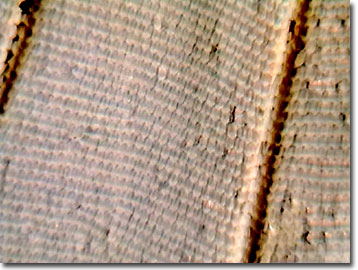Butterfly Wing Scale Digital Image Gallery
Clipper Butterfly
The clipper is one of the most photogenic butterfly species due not only to its beauty, but to the pose its members often strike. Clipper butterflies have a habit of resting or feeding on flower nectar open-winged for long periods of time. The sound and the flash of cameras pass by these models unnoticed, and not an antennae or wing flutters out of place.

Parthenos sylvia was scientifically described in 1775 by Pieter Cramer, a Dutch merchant of Spanish wool with a great interest in butterflies. The common name, clipper, is an allusion to the speciesí white wing patches that look like the multiple billowing sails on the mighty sailing trade ships of Cramer's day. The white patches are located on the clipper's forewings and stand out against a background that varies in color. The appearance of this Indo-Australian butterfly fluctuates across its broad geographic distribution. The wings may change in size and be blue, green, orange or brown, but the white patches remain unchanged in all of the 26 subspecies.
The clipper butterfly exhibits various modes of protection from predators during its many stages of life. The lives of larval clippers greatly depend upon their meal choices and they prefer to eat the leaves of passion vines and moonseeds. The brown and black striped caterpillars covered with rows of purple spines absorb some of the poisonous organic substances of the plants to make themselves noxious to predators. The chrysalides, however, try to avoid being seen by predators in the first place and appear green or brown, depending on the subspecies. Closely resembling a folded leaf, a clipper chrysalis is extremely difficult to spot in the forests they prefer to inhabit. Clipper adults are so brightly colored that they are easy to see, but protect themselves through unpredictability. Flying in erratic patterns through the tree canopy, clipper adults are difficult to attack or catch unless they stop to feed or rest.
Once captured, the clipper butterfly is relatively easy to breed and rear in a tropical butterfly enclosure. Sufficient quantities of its preferred larval food plant must be available, however, in order to appease the voracious caterpillars. Clipper butterflies are valued by collectors and wild individuals are marketed alongside cultured specimens from tropical butterfly ranches.
Contributing Authors
Cynthia D. Kelly, Shannon H. Neaves, Laurence D. Zuckerman, and Michael W. Davidson - National High Magnetic Field Laboratory, 1800 East Paul Dirac Dr., The Florida State University, Tallahassee, Florida, 32310.
BACK TO THE BUTTERFLY WING SCALE IMAGE GALLERY
BACK TO THE DIGITAL IMAGE GALLERIES
Questions or comments? Send us an email.
© 1995-2025 by Michael W. Davidson and The Florida State University. All Rights Reserved. No images, graphics, software, scripts, or applets may be reproduced or used in any manner without permission from the copyright holders. Use of this website means you agree to all of the Legal Terms and Conditions set forth by the owners.
This website is maintained by our
Graphics & Web Programming Team
in collaboration with Optical Microscopy at the
National High Magnetic Field Laboratory.
Last Modification Friday, Nov 13, 2015 at 01:19 PM
Access Count Since January 21, 2003: 9445
Visit the website of our partner in introductory microscopy education:
|
|
